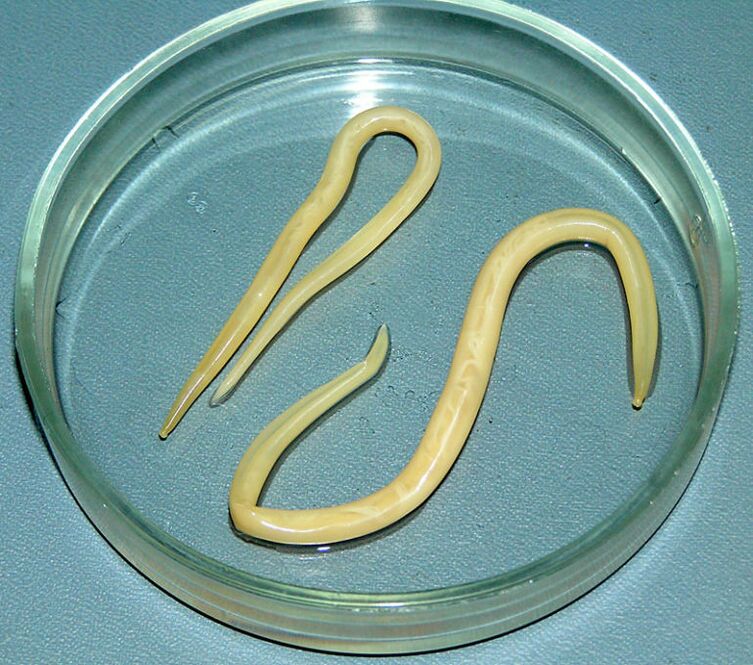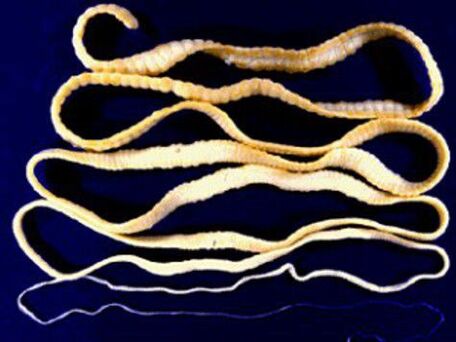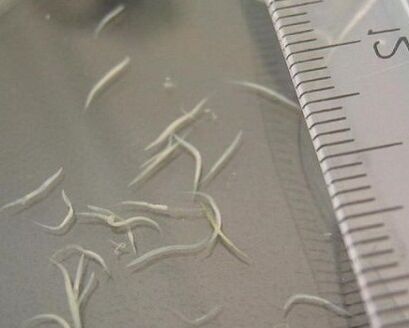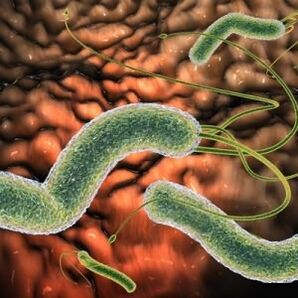Studies in the field of parasitic medicine are reported by alarming facts. Over 90% of all age categories of the population is influenced by the Elmintic invasion or has a hidden form of transport of various parasites. They cause many problems, causing various diseases that prevent a person's normal life. By choosing the habitat: the human body, parasites can practically spread to all organs and systems, causing pathological changes in them and violating the function of their work.

The main types of parasites in the human body
The group of parasites that made their habitat of the human body includes simpler microorganisms, round and tape worms:
- Speakers. These are small parasites (long, no more than one and a half cm), which are transmitted in a domestic way or in contact with an infected person. Very often, the flies that bring the larvae of these parasites of the worms are to the bearers of this Elmintic invasion. Once on the products, they remain for a long time and if they are not elaborated, they enter the human body. By propagating in the human body, they cause Entebiasis. Very often, preschool children and school age are subject to this type of illness. Enteriase lesions in children and in the adult population can reach up to 90 percent. The habitat of these parasites is the blind segments, the colonator of the intestine. This type of parasites does not breathe air; Oxygen is not necessary for its existence. The nutrients for it are the content of the intestine. After the mating, which occurs in the iloo of the ileum, crawling out of the anus, the female places the larvae in the area of the sphincter of the anus. The greatest danger that EntenoBobiasis is highly contagious. Parasites are very easy to infect with the slightest deviation from the individual hygiene rules.
- Askarids. They belong to the class of round worms. Parasite in the small intestine. Call the ascariasis. The source of infection is a sick person or an animal. The infection occurs through food, not the hands washed. Cysts of parasites worms, which fall into the ground, mature at the level of the larvae, are dangerous for humans. If a person has previously used unwashed fruit or vegetables, the body is infected. This is also facilitated by conditions of non -health residence, insufficient thermal treatment of food.
- Ankilostoma. Lead to the development of the pathological process in the body. This is a small parasite, which reaches no more than 2 cm in its length. Very often, young children are infected (especially in rural areas, due to bare feet).

- Large tape. It belongs to the group of striped worms, it has 12 varieties. The main parasitization site is the Intestine Department. The main path of body infection occurs when fish (which have not exceeded sufficient thermal treatment) or through objects that have been used to cut meat (knives, cutting boards). This type of parasites feed on all the beneficial substances used by a person. Its length can reach 15 meters.
- Bull and pork. These are ribbons, the length of which is 10 meters. When infected with spores of Toro's Tenia, tusiarincosis develops and, in the case of the larvae of the pork chain, Taeniasi disease develops, its larval stage is called cysthracosis. The development of these pathologies is often facilitated by fueled meat, poorly transformed. But sometimes the infection can occur through unwashed hands and food. As a rule, in the tenuous intestine of the body, when infected with this disease, a striped worm screw. In some cases, the duration of its existence can last up to 20 years. Since, with the help of his hooks, which are found on the parasite's head, it is strictly attached to the wall of the small intestine. And therefore, sometimes difficulties arise for his retreat.
- Echinococci. These are worms of ribbon up to 8 mm in length, they can cause a disease called echinococcosi. The disease is often found in animals (cats, dogs, foxes, wolves). It should be noted that the human body, for Echinococcal pathology, is an intermediate place of residence. The infection process occurs during direct contact with the animal or when cutting it. This type of disease is more influenced by the rural population engaged in zootechnics. The disease occurs very often without symptoms and, in the case of their manifestation, cystic formations occur. To remove them, it is necessary to use only the surgical method.
- Lambia. Bring to the development of Lambliosis. Parasites belong to the Zhgutikov class, they are representatives of the demolomonadide detachment. A favorite habitat is a soft intestine of a person or animals. Sometimes they can influence the digestive system of birds. The infection occurs in two ways: sometimes there is infection through the respiratory tract. The cysts enter the body through the lungs, together with inhaled dust, the clinical picture in this pathology can be masked like other diseases. And it is accompanied by the development of diseases of the nervous, cardiac and endocrine system.
- Parasitic mushrooms. They are able to cause different pathological conditions in the human body (actinomicosis, lichen, microsporia, tricophyted, favus, erytrazm). They live on the human body, hitting the skin, hair, phalanx nails.
- Parasites of African malaria. This group includes malarial plasmodes. I am able to cause malaria. This disease is transmitted only through mosquitoes. For our area, this disease is unusual. It is subject to people who live in southern countries. Such infectious disease can develop when visiting these countries. A feature of this disease is that local residents have the opportunity to become much lower than tourists. This is due to the fact that they develop immunity.

The infection is based on different basic ways:
- Fecal-orale. The use of unreal vegetables and fruit, not boiled water.
- Early. With this type of infection, the elfintic invasion larvae fall through the pores of the skin.
- Contact-Household, through the articles for everyday house or in contact with the infect.
A characteristic of all forms of eliminated parasites is that they eat at the expense of their owner (person or animal), while selecting useful nutritional ingredients (glucose, useful microelements and macroelements, carbohydrates). As a result of such a pathological effect, the body begins to experiment with an acute lack of potassium, magnesium, zinc, silicon, selenium and many vitamins. Another feature of these parasites is a high degree of adaptation. They adapt to the working conditions of the owner's body. And they are made invisible to the immune system.
The causes of the infection with the parasites of the human body
Among the ways of infection, the following can be distinguished:

- The eggs and parasitic larvae penetrate the body when using dirty and not pedaling water. Or when you eat food (fish, meat, canned food), which have not received enough thermal treatment. This is also facilitated by eating unreal vegetables and fruit.
- Elminto's eggs and cysts remain on the surface of the skin with direct contact with everyday objects (doors handles, money, toys, stairs). In addition, the source of infection can be contained in the ground, when contacting the ground, the spores of the parasites fall on the hands. And if they are not completely washed, this also creates a risk of threat of body infection with various types of helmets. Therefore, the hands must be washed not only before eating, but also several times during the day, especially if there is contact with the ground.
- Various insects (flies, wasps, fleas) create a real threat of worms infection. For this, the insect must not make a bite. It is sufficient that, sometimes they freely penetrate the home and sit on the food, on the cutlery, leaving the spores of the larvae of the worms of parasites on them.
If daily work consists in direct contact with animals (veterinarian, rural resident, cattle), the probability of the disease increases significantly.
The main signs and symptoms of parasites in the body
A very important role in the appearance of the first basic signs and symptoms with the development of elf invasions is occupied by their position and capacity in the human body. Very often they settle in the upper parts of the small intestine (wide ribbon, bull chain and pork, ascarids).

Vlasov, for his habitat, chooses the Signage of the Crassus intestine. Opistorchosis affects the biliary trait of the ducts. Pinworms are found in the lumen of the colon and rectum. Serious dangerous diseases may appear:
- Pain during urination.
- Adenomatous growth.
- An irregular and painful menstrual cycle.
- The appearance of hepatitis and dermatitis.
It is very important to pay attention to the above symptoms. Despite the fact that, at first glance, they seem harmless, in fact, these signs can indicate the presence of parasites in the body.
The symptoms that appear when the parasite the body are often perceived by patients such as the presence of any other disease that is not associated with the appearance of worms. This is a great difficulty in making an accurate diagnosis. The main symptoms in the development of parasitic worms in humans:
- Violation of the defecation act (constipation). It seems due to the fact that the accumulation of worms makes it difficult to pass the stools on the intestinal lumen.
- Sometimes diarrhea is observed. This is due to the greater production of Ferminas (substance similar to the hormone, produced in the corps of parasites) and leads to an imbalance of chloride ions. What explains the cause of diarrhea.
- Increased gas formation.
- There is a violation of the elaboration and assimilation of the Lanolina (Grasso). This is due to the fact that by parasite in the lumen of the small intestine, parasites cause inflammatory diseases of the intestinal mucosa.
- Arthralgia and muscle pain occur.
- As a response of the body, manifestations of allergies arise, sometimes in the form of urticaria.
- Perhaps the development of ulcerative eczema, skin dermatitis, the appearance of tumors.
- In the case of the development of the helintiasis, which feeds on blood elements, iron deficiency anemia is possible.
- With an examination of clinical blood, a small amount of red blood cells, a reduced hemoglobin level and you notice a decrease in the color indicator.
- Very often, granulomas of the abdominal or uterine cavity, in the lungs and liver.
- The patient's psychoemotive state is compromised, which is expressed by unreasonable aggressive conditions, increased increase.
- Due to the serious itching in the anus, night sleep is disturbed.
- At night, the patient has a touch of teeth (bruxism).
- The lack of choline, vitamins, amino acids, proteins and carbohydrates leads to the development of chronic fatigue, a rupture of forces.
- The constant feeling of hunger, the development of anorexia symptoms.
- Cardiac muscle disease, heart failure.
- In serious cases, the development of oncopathology.

Not only the type of parasite that has deposited in the human body, but also its age, sex, physical characteristics of the body, has a significant impact on the clinical picture.
With the development of the acute phase of the damage by the elmintic invasions, the patient has all the signs of acute poisoning of the entire body:

- Nausea, transforming into an indomitable vomiting.
- Hyperthermia (sometimes at high numbers 38, 9).
- Anorer rashes.
- The regional lymph nodes are inflamed.
- The pathological processes in the liver and lungs are aggravated.
If such a symptom appear, the visit to the doctor is vital
Diagnosis of parasites in the human body
For an accurate diagnosis, it is necessary to consult a parasitologist. But often in the city clinics there is no standard unit. Therefore, it is necessary to contact a therapist or gastroenterologist for subsequent tests and further consultations of a parasitologist of infectious diseases. For a long time, the determination of the infection with parasites was carried out only by conducting fecal tests for the presence of worm eggs or a duodenal sound. A fence of the material of the content of the intestine was performed.
Introducing a probe. These research methods do not always reveal the presence of worms in the human body. Modern diagnostic methods (Elisa test) allow you to detect and determine any form of parasites in the human body. They are based on the identification of antibodies that the body produces in response to the intossation caused by the Elmintic invasion. In addition, serological techniques have been widely used:
- Reef.
- RAL.
- RSK.

As an additional research method, it is used:
- Endoscopic examination.
- Ultrasound.
- Mri.
- Endobiopsy.
- Establish an accurate diagnosis using PCR.
Relatively recently, a system-winning has appeared. It is able to detect endotoxins, microbial flora and tumor cells using an expanded electromagnetic interval. With the help of frequency resonance therapy, it is not only possible to diagnose, but also the effective therapy of any form of helminths, regardless of where they live.







































